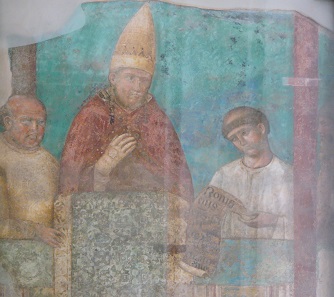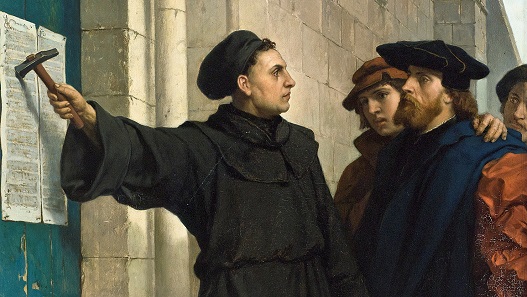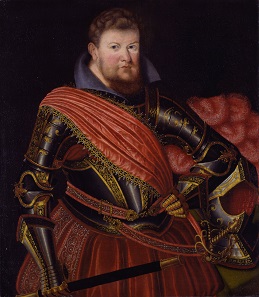Dorothea of Saxony (1519-1617), sister of Christian II, Elector of Saxony and abbess of Quedlinburg Abbey since 1610, preferred living in the residential city of Dresden to living in provincial Quedlinburg. But of course she still insisted on organising the festivities on occasion of the Reformation jubilee from 31 October until 2 November 1617 in her small domain, herself. Although nowadays, 500 years and four Reformation jubilees later, this may seem quite natural and obvious to us, at the time it was a sensation. After all, it was the very first time a Reformation jubilee took place.
Bonifatius III proclaims the first holy year. Contemporary depiction of Giotto from the Archbasilica of St. John Lateran.
What is a jubilee?
Jubilee: ‘a special anniversary of an event’, that is how the Oxford English Dictionary defines the word today. But the original meaning was very different. It had a religious overtone and it was reminiscent of the Old Testament Jubilee, which the popes had reshaped to a ‘holy year’. Since 1300, the pope started proclaiming a holy year – first every 100, then every 25 years – which entails a special remission of sins.
Luther posts his 95 theses to the church door of Wittenberg. Historic painting by Ferdinand Pauweis (1830-1904).
The ‘holy year’ of the Protestants
Theologians from the University of Wittenberg applied this Catholic concept to Protestant matters. On 27 March 1617 they asked the highest Saxon church authorities if they could celebrate a ‘primus Jubilaeus christianus’, a Christian jubilee, on 31 October 1617, the date where Luther posted his theses to the church of Wittenberg, according to Protestant tradition. And this was not all.
Christian II, Elector of Saxony (1583-1611). Painting by Zacharias Wehme at the Staatliche Kunstsammlungen Dresden.
The political aspect
The Elector of Saxony found this idea so intriguing, that he took it over for himself. He ordered such a jubilee for all churches in Protestant Saxony. The clerical advisors of the ruler worked out a detailed schedule for this celebration, which would take three days and consists of several celebratory church services.
Christian II thus hoped to redeem his dwindling reputation as leader of the Protestant Estates. His cooperation with the (Catholic) emperor had damaged his credibility. By sending his own jubilee note to all Protestant rulers and cities, and by recommending that they also celebrated this festival, he hoped to regain some significance in the competition against the Calvinist Electoral Palatinate, which was competing with Saxony for supremacy in the Protestant world.
Quedlinburg. Dorothea of Saxony, 1610-1617. 8 ducats 1617, Quedlinburg. Very rare. Very fine. Estimate: 25,000 euros. From Künker sale 294 (2017), No. 3732.
The compliant sister
Of course, Dorothea of Saxony supported her brother’s policies. She also ordered a three-day Reformation jubilee for her Quedlinburg Abbey, following the Saxon example. And apparently, she had a number of precious commemorative coins minted, one of which is the coin that will be put to auction with the lot number 3732 in the June sale of Künker in 2017.
Coins like these were given out during many important celebrations in Early Modern times. They were diplomatic gifts, sent to befriended and allied princely courts. That is why they were minted with many different denominations, to match the significance of the receiver of the coin. We know that from the two obverse dies and the one reverse die, which were cut for the celebratory emission, they made golden strikes at the weight of 10, 8 1/2 and 8 ducats, as well as double and single talers.
The obverse shows the big family coat of arms of the abbess. The reverse is rather surprising for a Reformation jubilee. You would have expected a depiction of Martin Luther or an iconographic hint at his work. Instead the mint of the Quedlinburg abbess Dorothea presents Henry the Fowler, German king from 919 until 936.
Quedlinburg castle with abbey church. Photo: A. Preussler / CC BY-SA 3.0.
Henry the Fowler and Quedlinburg
Henry is wearing the royal coat and crown. He is holding the imperial sword and the imperial orb. To his right and to his left, we can see the church buildings of Quedlinburg. The field tells us his birth-and-death dates: Born in 876, deceased in 936. The inscription reads – in translation – King Henry, by the grace of God, Emperor of the Romans, Duke of Saxony, founder of Quedlinburg abbey.
And that is the reason, why Dorothea chose such an unusual depiction for her coins. Henry the Fowler from the Ottonian dynasty was Duke of Saxony before he became German king in 919 and thus brought the ruling dynasty of the Ottonians to power. Dorothea used this effigy to emphasise the immense significance of the Saxon duke for the fate of the empire and covered it up with the fact that Henry was buried in Quedlinburg and that he was the supposed founder of the abbey.
Dorothea of Saxony died only two weeks after she had celebrated the Reformation jubilee in Quedlinburg. Another Dorothea followed her as abbess, Dorothea Sophia, daughter of Friedrich Wilhelm I, Duke of Saxe-Weimar.
The Künker sale at which these coins will be offered can be found here.
And the relevant CoinsWeekly auction preview can be read here.









